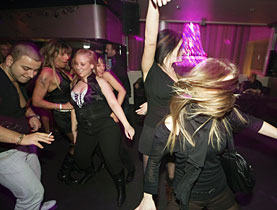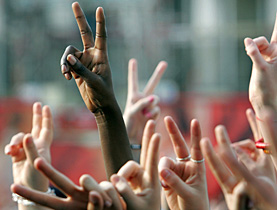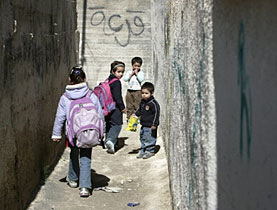Traditional Easter march now has peace themes

Easter marches in Switzerland have evolved over the years from "ban the bomb" to demonstrations that promote peace in its widest sense.
This year’s march in the capital, Bern, was directed against the social marginalisation of migrants and called for harmony with them. It attracted almost 600 people.
The vision of United States President Barack Obama of a world without atomic weapons is similar to that of those who took part in Easter marches in the 1960s.
But the issue has no longer been at the forefront of recent Swiss Easter marches.
In 1958 around 10,000 people marched at Easter from London to the nuclear research centre at Aldermaston to demonstrate against the build-up of nuclear weapons.
As a result a tradition developed in a number of west European countries, which at times took on the proportions of a mass movement.
Three days march
The first Easter march in Switzerland took place in 1963, starting in Lausanne and ending in Geneva three days later.
They were beautiful spring days, recalls Ruedi Tobler, president of the Swiss Peace Council. He was 16 at the time and wanted to see Geneva.
“I was certainly against atomic weapons but I had my doubts about the usefulness of such marches,” he said. The three days in the vineyards changed his attitude.
“Although only a few hundred people took part, it had a big impact.”
There was much discussion beforehand about how an Easter march should be organised. Many hesitated because they feared it could be counter-productive in what was a delicate political phase.
Risk of rift
In 1958 the government said Switzerland needed atomic weapons. The question on how to react to that [intention] threatened to cause a rift among those on the left of the political spectrum.
Should the reaction be a categorical “no” or should there be a demand for conditions? In the end, two people’s initiatives were launched and both were clearly tuned down.
There were internal differences of another kind among the Easter march activists. Some at the outset advocated that the civil use of nuclear energy should also be denounced; others vehemently disagreed.
There were also disputes about how to tackle other issues. When Vietnam War opponents carrying Ho Chi Minh flags turned up at the 1967 Easter march from Biel to Bern, the march was disrupted. It was the last Easter march for a time.
“From 1968 the various groups could not agree on joint action,” Tobler recalled.
Opposition fuelled
The tradition was resurrected at the beginning of the 1980s. In the meantime a treaty on the non-proliferation of nuclear weapons had been worked out. But the Nato decision to rearm fuelled opposition, particularly in Germany. Plans to deploy nuclear missiles there provoked a new peace movement.
This also reached Switzerland and in 1982 about 30,000 people took part in an Easter march in Basel.
During the 1980s the subject matter was broadened, with environmental issues coming to the fore.
“There was a growing realisation that not only nuclear weapons could destroy the world,” Tobler said.
At the same time, new forms of action developed. At the end of the 1980s the Easter march movement petered out.
But it came back to life again in 2003 in the course of protests against the Iraq War. About 1,000 people participated in the Easter march in Bern and since then it’s taken place every year, with a focus on Switzerland as a whole.
Stop marginalisation
The organisers, peace and church organisations, agree on one main issue: this year’s march has as its motto “Stop Marginalisation – Peace for Migrants”.
Albert Rieger from the Centre of Ecumenism, Mission and Development says the issue of “peace” has many aspects and is inseparable from fairness.
The feminist peace organisation cfd also considers it wise to focus on one particular theme in Easter marches, based on a broad peace concept. Perhaps one day it will be Obama’s nuclear disarmament idea, says Franziska Müller from cfd.
“But perhaps we can turn our attention to other issues if Obama embraces the nuclear question,” she said.
swissinfo and Charlotte Walser, InfoSud
The sponsor organisations of the Bern Easter march criticise Switzerland’s asylum policy.
“We insist on the real function of asylum legislation. It says: protect people, do not hinder migration,” they said in a statement.
The organisers expect several hundred people will take part in the march along the River Aare, the same as over the past few years.
Another Easter march is taking place in the Rhine valley in canton St Gallen. The march along the old Rhine will focus on the closing of the Swiss border during the Second World War.
The march focuses on Jewish refugees who were turned back at the Swiss border, but also on those people who seek protection in Switzerland today.

In compliance with the JTI standards
More: SWI swissinfo.ch certified by the Journalism Trust Initiative




You can find an overview of ongoing debates with our journalists here. Please join us!
If you want to start a conversation about a topic raised in this article or want to report factual errors, email us at english@swissinfo.ch.